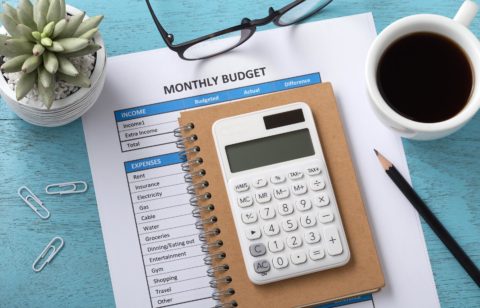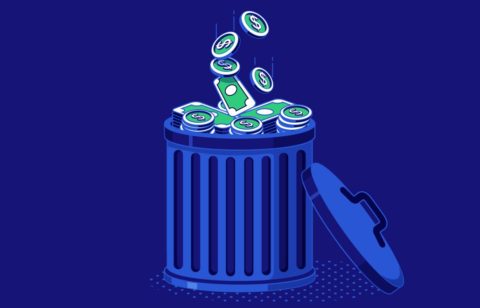Do you make a resolution year after year to get your finances under control? If so, how’s it going? If you’re like most, you probably have nothing to write home about. It’s never too late to get back on track. The first thing you’ll need to do is build a budget. This used to be a very complex task; however, it’s now a breeze thanks to budgeting and planning apps. By downloading the ideal budget app for your needs, you can formulate a plan to pay off debt, save money, and budget for future expenses.
Using a budget app can turn your iPhone or Android into a personal money management machine. Additionally, these apps are so sophisticated they can even act like a personal financial advisor by helping you find wasteful spending and identifying ways to save money. By automating many functions that you used to have to do manually, building and maintaining a budget has never been easier. These budget apps can also be a very effective learning tool for many who have no experience in managing money.
Each app has different features and benefits to help you, so be sure to check a few out before choosing one. Once you start using a budgeting app, you may find, over time, that you outgrow it and need something a little more sophisticated. This is healthy and means you’re increasing your knowledge and skills in managing your money.
There are many apps on the market, with new ones springing up every day. It’s important to spend time evaluating any app you’re considering to ensure you don’t endure the painstaking task of setting it up more than once. Different apps focus on different things, so take the time to prioritize what you need in an app.
Read our 10 Best Budgeting Apps to help you avoid debt.
Here are some of the best apps available; let’s take a closer look at what they have to offer.
1. Mint
Mint is a well-known budgeting app that has been around for a long time. It’s very easy to use and can sync to your bank account to gather the details necessary to help you create a personalized budget. Mint was created by Intuit, the same company that created QuickBooks and TurboTax. So you can feel confident by operating on the same secure platform utilized by banks. Not only can you plug in your banking information, but you can also tie Mint to your credit card accounts, brokerage accounts, and other lending and financial institutions.
Mint is very helpful in managing your finances in a number of ways. Not only is budget building seamless and easy, but Mint also helps guide your day-to-day spending. It automatically categorizes your expenditures, alerts you to unusual spending and helps reduce fees you may incur. By alerting you when you go over budget, keeping you abreast of your credit score, and tracking your spending by category, Mint can always give you a great snapshot of your financial picture. Mint also includes a bill paying function that helps you stay on track and avoid any missed payments that could hurt your credit score.
Cost: Free
Premium Version: No premium version available
Apple Store Reviews: 4.8 with 750,000+ ratings
Google Play Reviews: 4.4 with 200,000+ ratings
2. PocketGuard
PocketGuard is an app that focuses on helping you manage your spending. It also links to all your financial accounts and provides excellent visibility into your total financial picture. The app is one of the easiest to set up and does an excellent job of tracking your income, savings, and bills throughout the month. It also analyzes your bills and looks for ways you could potentially save and find better deals on monthly expenses such as your phone bill, cable services, and Internet service.
The app is especially good at helping you manage your cash flow by projecting expenditures in the near future and accounting for your expected income. The interface is very simple to use and offers easy-to-use charts and graphs to provide a snapshot of where you stand financially. PocketGuard offers apps for iPhone and Android devices, as well as a desktop version. You can even access the app from your Apple Watch.
Cost: Free
Premium Version: PocketGuard Plus is $7.99/month, $79.99/year, $99.99/lifetime membership.
Apple Store Reviews: 4.7 with 6,600+ ratings
Google Play Reviews: 4.2 with 1,880+ ratings
People Also Read
3. You Need a Budget (YNAB)
You Need a Budget is a hip and culturally current app that has developed a big following among young professionals. Utilizing money management tools that are different from traditional budgeting tools, You Need a Budget takes a different approach to managing your finances. Instead of focusing on the more common methods of categorizing your money and expenditures, the app focuses on four simple rules.
In essence, each dollar of your income is given a task, such as bill paying, saving, or investing. By accounting for every dollar each month, it helps you cut down on overspending. Keeping it simple helps you avoid the stress and pain of building a full-blown budget. In addition, the app helps you plan for unexpected or infrequent expenses. It helps you get ahead so you’re not living paycheck to paycheck while also teaching you to be resilient if unexpected overage occurs.
You Need a Budget also offers free online classes to teach you about money management, as well as a free introductory period so you can try it out. It also provides goal-tracking tools to meet your savings goals and any other goals you have for paying off your debt. You Need a Budget has apps that work on your desktop, Android, or iPhone.
Cost: 34-day free trial
Premium Version: $14.99 per month, $99 per year
Apple Store Reviews: 4.8 with 40,800+ ratings
Google Play Reviews: 4.6 with 11,300+ ratings
4. Wally
Wally focuses solely on budgeting, which is all some people really need. While it’s basic in its offerings, it does a good job of tracking your income, expenses, and your remaining discretionary income. The app is completely free and offers the option to track your expenses by entering them manually or by snapping a picture of your receipt. Wally also provides alerts when your bills are due, when you reach certain milestones such as a savings goal, or any other activity you want to keep track of.
As with most of the budget apps available, Wally offers apps for iPhone, Android, and desktop. Wally supports almost all foreign currencies.
Cost: Free
Premium Version: Wally Gold is $1.99/month, $24.99/year, $39.99/lifetime membership
Apple Store Reviews: 3.9 with 1,600+ ratings
Google Play Reviews: Unavailable
5. Goodbudget
Goodbudget uses a traditional envelope approach to budgeting but on a digital platform. It’s very good for couples looking to manage their finances together. The app provides complete visibility across all platforms and devices in real time so both parties can see where their money is and where it’s going. It also has some specialty features that help couples learn to save for big-ticket items such as cars and vacations. While this is an excellent app for couples, it’s equally as useful for single consumers.
With each paycheck, consumers add money to their envelopes as needed to pay bills, reach certain goals, and save money. Once the money is allocated, it’s easy to see how much discretionary income is left over. By doing this, consumers are able to keep from overspending. The basic app is free and allows up to 10 envelopes. The pro version is more robust and allows for more envelopes, account history, and provides other financial tools.
Cost: Free
Premium Version: GoodBudget Plus is $8.00/month, $70.00/year
Apple Store Reviews: 4.7 with 12,700+ ratings
Google Play Reviews: 4.3 with 19,100+ ratings
6. Simple (PNC Virtual Wallet)
PNC is a financial services company that offers personal banking services including checking and savings accounts, mortgage and auto loans, credit cards and more.
PNC Virtual Wallet is offered through PNC Bank, so you will first need to open an account with them to use the service. You can view upcoming paydays and payments and the amount of money that’s available to spend. Stay on track by categorizing your spending and budget within each category. PNC offers a Mobile banking app that includes a virtual wallet.
Cost: Free
Premium Version: Unavailable
Apple Store Reviews: 4.8 with 1,200,000+ ratings
Google Play Reviews: 4.4 with 211,000+ ratings
7. BUDGT
While BUDGT only works for iPhones, it’s a great little app with a lot to offer. The app makes it easy to add your income and any recurring expenses to get you started on the budgeting bandwagon. T It has a focus on daily budget management, providing real-time status on where you stand with your money. This can help you make better decisions and curtail unnecessary spending and impulse purchases. By having the ability to view daily status, you can determine whether the purchase you’re considering is in keeping with your budget. The app can also give you cash flow projections at points in the future.
BUDGT has easy-to-manage categories and is a simple and intuitive budgeting tool. Its unique daily views help you keep a tight hold on your money.
Update: No longer a free version
Cost: 2.99 €
Premium Version: Unavailable
Apple Store Reviews: 4.7 with 9 ratings
Google Play Reviews: Unavailable
8. Mvelopes
Mvelopes is a digital envelope budget method app that can help you gain better control over your money. The app has been around longer as compared to other similar apps. Because of its longevity, the app’s developers have been able to improve it into a very robust tool that has many features for all levels of budgeting expertise.
Mvelopes provides three different product levels to consider, namely Mvelopes Basic, Mvelopes Plus, and Mvelopes Complete.
The advantage of using an envelope system is the ability to put your money into as many envelopes as your personal financial situation calls for. This way, you can account for every penny in your budget. Every product level allows for as many envelopes as you need. You can tailor your digital envelope budget to be as detailed as you want while keeping everything in one place.
The app offers every user live support through phone or chat, regardless of product level. . . Some levels offer multiple resources such as a personal finance trainer who can offer quarterly consultation and advice. On the website, you can find many resources in the company’s Learning Center.
The company feels that since everyone’s financial situation is unique, it needs to offer a variety of services for customers to consider. Users can pay bills and manage their budget from iPhone, iPad, Android, and desktop.
Cost: 30-day free trial
Premium Version: Basic $5.97/month, Premier $9.97/month, Plus $19.97/month
Apple Store Reviews: 4.4 with 4,200+ ratings
Google Play Reviews: 3.2 with 3,640+ ratings
9. Unsplurge
Unsplurge is a fun app that’s completely different from other budgeting apps because it’s not meant to be a total budget management tool. Rather, it’s designed to help you budget and save up for a specific item or event. Whether you’re trying to save for a new car, a down payment on a house, a vacation, or a wedding, Unsplurge offers the focus you need to reach your goal.
It monitors your progress and offers tips to help you get there. It’s effective by helping you carve out money from your normal expenditures and direct it towards the purchase of something you really want. And, it helps you avoid incurring debt in order to buy those big-ticket purchases. Unsplurge is a free app for iPhone.
Cost: 30-day free trial
Premium Version: Unavailable
Apple Store Reviews: Currently Unavailable
Google Play Reviews: Unavailable
Regardless of which budget app you choose, you’ve made a smart decision. Getting ahold of your finances is the key to eventual financial success and satisfaction. Budgeting helps you to make the most of every dollar and make the best decisions with your everyday spending.
Keeping track of your money can help you avoid debt, or even help you pay it off. If you don’t currently have a savings or emergency fund to fall back on, utilizing a budgeting app can help you get started. With everything that’s available to you to help manage your money, there’s no reason not to take advantage of them. Try one or more of these great money management solutions and get on your way to reaching your financial goals.









